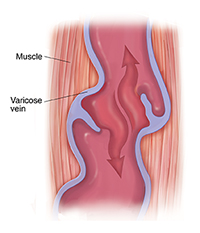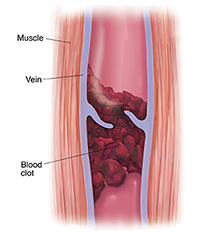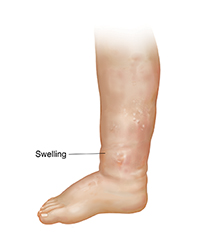Leg veins carry blood from your feet and legs back to your heart. If a vein is damaged, it may cause problems in your legs.
The problems that may happen from damage to the veins include:
-
Varicose veins. This is a swollen, twisted vein located close to the skin.
-
Deep vein thrombosis (DVT). This is a blood clot in one of the deep veins, usually of the legs. The clot can separate from the vein and travel to the lungs (pulmonary embolism or PE). In the lungs, the clot can cut off the flow of blood. These two conditions together are called venous thromboembolism (VTE).
-
Chronic venous insufficiency. This is a long-term problem with the veins not working well.
Your healthcare provider can give you more information on these conditions and how to prevent and treat them.
When to call your healthcare provider
Call your healthcare provider right away if you have pain, swelling, or redness in one of your legs. These are the symptoms of a blood clot.
Call 911
Call
-
Chest pain
-
Trouble breathing
-
Fast heartbeat
-
Sweating
-
Coughing (may cough up blood)
-
Fainting
These are the symptoms of a blood clot that has traveled to the lungs. This is a medical emergency and may cause death.




